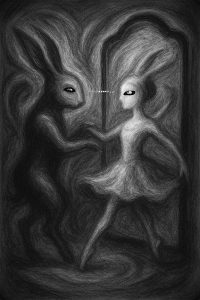The first and most basic MAEL rule is to signal: ‘I am not a threat. I am not dangerous.’This is achieved by keeping your body still and quiet. As the moment of encounter cannot be planned or predicted, surprise is always a factor. Therefore, it‘s essential to practice the desired posture in advance. The general attitude can be characterized by qualities such as calmness and attunement.
The desired posture is one of awareness and focus. At the same time, it expresses openness and kindness. By the latter, I mean adopting a welcoming stance, informed by gratitude for the presence of the deer, rabbit or black bird. This can be achieved by performing an ‘inward bow’ as a gesture that conveys this gratitude to the ground squirrel, pheasant or hare for sharing this particular moment with you.

If you succeed in creating a situation in which curiosity outweighs fear, causing your counterpart to stop and look at you, then you have entered the second phase of the encounter. This is when glances can be exchanged as a means of exploration and contact, and resonance can emerge. Throughout the project, this phase has evolved into a dance: While it may seem to be a state of immobility from the outside, inside there are the aforementioned bows of gratitude, followed by what I started to envision as a ‘dance en pointe’, a point dance.
I use this dance term to evoke images of silent, gravity-defying movements, with the body focused on a single point to minimize the threat posed to a hare by human flesh. A spinning motion takes place and, in the middle of it, the hare is gently taken by the paw and invited to turn, opening up the possibility of a shift in perspective for us both.
From the outside, the most that can be observed is a dance of glances – until the moment passes and – either the hare or I – continue on our way.
The relationship between dance and imagination is a prominent topic in dance research – not only in regard to the benefits of rehearsing the movements in your mind before performing a dance in the real world, but also in relation to fostering empathy and interconnectedness. Examples of the latter can be found in Petra Kuppers’ work. In Eco Soma – Pain and Joy in Speculative Performance Encounters, she writes:
Eco soma slows the speed of consumption and reception. I conceive of this as an ecopoetic move to notice and imagine. (Kuppers1, 2022, p 11.)
This motion of noticing and imagining closely aligns with the wildlife encounter practice developed as part of the MAEL project.
- Kuppers, Petra. 2022. Eco Soma. Pain and Joy in Speculative Performance Encounters. University of Minnesota Press. ↩︎
